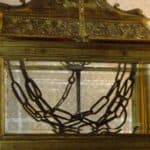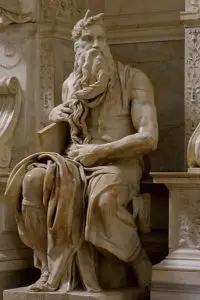Rome: The Basilica of Saint Peter in Chains
San Pietro in Vincoli (Saint Peter in Chains) is a minor basilica in Rome that houses Saint Peter’s chains and Michelangelo’s famous Moses statue. Both are major attractions for those visiting Rome and you should definitely plan to stop here if you have the opportunity.
The Apostle Peter was arrested and jailed in Jerusalem for preaching about Jesus. He was placed under guard and shackled with an iron chain. But the night before his trial, St. Peter was said to have been released from the chain by an angel and led out of the prison right under the nose of the guards. The chains that had bound Saint Peter were given to Pope Leo by Empress Eudoxia (wife of Emperor Valentinian III).

According to tradition, when the pope held them next to the chains from Peter’s first imprisonment in the Mamertine Prison in Rome, the two chains miraculously fused together. San Pietro in Vincoli was dedicated in 442 to house the two chains that bound Saint Peter. They remain fused together and are kept in a reliquary under the main altar in the basilica.
We celebrate the feast of Saint Peter in Chains on August 1.
The interior has a nave and two aisles, with three apses divided by antique Doric columns. The aisles are surmounted by cross-vaults, while the nave has an 18th century coffered ceiling, frescoed in the center by Giovanni Battista Parodi, portraying the Miracle of the Chains (1706).

The statue of Moses is depicted with horns: signifying “the radiance of the Lord”, due to the similarity in the Hebrew words for “beams of light” and “horns”. This kind of symbolism was common in early sacred art, and for an artist, horns are easier to sculpt than rays of light.
Other works of art include two canvases of Saint Augustine and St. Margaret by Guercino; plus the monument of Cardinal Girolamo Agucchi designed by Domenichino, who is also the painter of a sacristy fresco depicting the Liberation of St. Peter (1604).
The altarpiece on the first chapel to the left contains a painting by Cristofor Roncalli: “The Deposition” (the body of Jesus being taken down from the Cross). Also in the Basilica, is the tomb of Cardinal Nicholas of Kues (d 1464), with its relief, “Cardinal Nicholas before St Peter”, by Andrea Bregno.
The painter and sculptor, Antonio Pollaiuolo, is buried at the left side of the entrance. He is the Florentine sculptor who added the figures of Romulus and Remus to the sculpture of the Capitoline Wolf on the Capitol.
The tomb of Cardinal Cinzio Passeri Aldobrandini, decorated with imagery of the Grim Reaper, is also in the church.
Finding the Basilica of Saint Peter in Chains in Rome:
Address: Piazza di San Pietro in Vincoli, 4/a, 00184 Roma, Italy
GPS coordinates: 41° 53′ 36.8304” N, 12° 29′ 33.054” E
Tel: +39 06 9784 4952
There is no official website for the Basilica.
⇐ Back to Catholic shrines and places of interest in Rome


If you can make time this is definitely worth the visit. Not only will you see what is mentioned above but also the sarcophagus of the woman and her 7 sons from 2 Maccabees 7 is there right under the chains of Peter. In this book, a woman and her sons are persecuted one by one for their upholding belief of God. It brought tears to my eyes. It is a very powerful Basilica. Take the time, you won’t regret it!
It’s easier to get to the Basilica from via Cavour. Take the steps opposite the Grand Hotel Palatino. The church is just past the top of the steps.
Is it possible for a mass to be said in someone’s honor at sSt Peter In Chains?